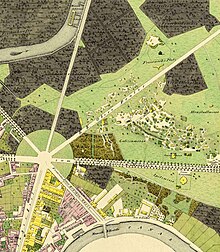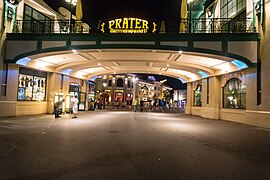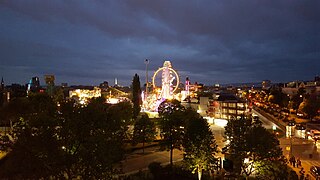Wurstelprater
| Wurstelprater | |||
|---|---|---|---|
|
View over the Prater from the ferris wheel |
|||
| place | Vienna | ||
| opening | 18th / 19th century | ||
| Visitors | almost 3 million ( estimated 2010 ) | ||
| surface | approx. 0.3 km² | ||
| staff | more than 1,000 in approx. 250 independent companies | ||
| Website | www.praterwien.com | ||
|
|||
Coordinates: 48 ° 12 ′ 53 " N , 16 ° 24 ′ 8" E
The Wurstelprater is the nationally known amusement park in Vienna , officially as early as 1825 Volksprater, often simply called the Prater. Its landmark, the Wiener Riesenrad , is located in the northwestern part of the Prater recreation area , near the Praterstern , in the 2nd district, Leopoldstadt .
history
The Wurstelprater, as the amusement park is unofficially but consistently called, owes its name to a character from the popular theater, the " Hanswurst " created by Josef Anton Stranitzky . During the Enlightenment in the late 18th century, these popular stages were driven from the marketplaces of today's old town and found new locations in the Prater, which was opened to the public by Joseph II in 1766.
The part of the Upper Prater , equipped with entertainment establishments, was already called the Volksprater in the Biedermeier period . On the occasion of the world exhibition in 1873 , because of which the Wurstelprater was demolished in the early summer of 1872, the name Volksprater was officially set by the city administration. Today the term Volksprater is used officially, e.g. B. on the electronic city map of the Vienna city administration, but is otherwise rarely in use.
In a list of Prater establishments with over 80 items drawn up in 1825, the following can be found:
- Plastic visuals, among which the Wieliczka mine and the St. Petersburg flood are the most excellent.
- Coffee house, as well as a large salon, in which visitors can enjoy a well-attended harmony music on Sundays and public holidays even in winter.
- Bar and bird shooting.
- Mechanical arts.
- Bar next to the kais. Swimming school. (At that time the Prater reached as far as Stadtgut or Schwimmschul Allee , today's Lassallestrasse , which led to the Fahnenstangenwasser , an arm of the Danube.)
In the last decades of the 19th century the Wurstelprater crossed the exhibition street to the north. Some entertainment businesses settled in the Venediger Au , the most prominent in 1892 was the Circus Busch in the panorama building built in 1881. In the following decades, the Venediger Au entertainment district expanded to an area of 48,250 m². In addition to the Busch Circus , there were riding stables, beer depots and various show booths.
Around 1900 there was probably the world's first theme park in the Wurstelprater - “ Venice in Vienna ”. It was built by Gabor Steiner in 1895 and recreated the lagoon city on the Prater's Kaiserwiese (between Praterstern and Riesenrad) in a smaller format. Water channels were created, lined with fairground booths and other entertainment options. New attractions were added every year for the summer season.
The Ferris wheel was built in 1896/97 and is now one of Vienna's landmarks. In the twenty years before the First World War , the Wurstelprater achieved peak values in terms of supply and demand. In 1933, Friedrich Holzdorfer opened the ghost castle , one of the world's oldest ghost trains , on plot 96 .
During the Battle of Vienna , the Wurstelprater was almost completely destroyed in early April 1945. It was rebuilt or rebuilt in the following years, whereby the part in the Venediger Au was no longer included.
In autumn 1948, essential parts of the soon-to-be-world-famous feature film The Third Man were shot in the Prater .
In 1981 the comedy cinema between the exhibition street and the ferris wheel, the last existing Prater cinema, burned down and was not rebuilt. The cinema with around 1,000 seats had existed here since 1927 as the successor to a theater founded in 1845.
Former cinemas

From 1896, when the show booth were presented by Josefine Kirbes "Living Pictures", shortly after the first public film screening , developed in the Prater a lively theater scene. A few years later there were already five such show booths, into which the walk-in customers were lured by “people calling out ” and people could go in and out as they wanted, since no demonstration times were set. Many of the short silent films and reports were shot in the Prater itself. Only with the advent of longer silent films from around 1910 did the show booths become theater-like buildings with screening times.
Since the five already existing cinemas were doing good business, the Obersthofmeisteramt (Obersthofmeisteramt), which was directly subordinate to the emperor, decided in 1912 to increase the rent tenfold, while the other companies were spared. In return, the cinema owners were promised not to issue permits for further cinemas. Until 1920, when the previous regulation in the First Republic was now deemed to be invalid, no further cinemas were allowed to open in the Prater. Until the end of the monarchy, the chief steward's office always ensured that the emperor's interests were protected. The designation “palace” was not permitted for an establishment in the Prater.
In the heyday of silent films in the 1920s, Austrian and foreign productions were shown in real “film palaces”, which some of the former show booths developed into. The largest cinema was the Busch cinema, a former circus that held between 1700 and 1800 visitors.
The seven cinemas in the history of the Prater were:
- Kino Stiller ; Owner: Josef Stiller (son of Josefine Kirbes, who had shown short films in 1896). Until 1904/1905 there was also a shooting range at this location, Prater No. 77. Soon, however, the location was used exclusively as a cinema with 602 seats and was later expanded to 705 seats on the first floor. The cinema was closed in 1927.
- Kino Schaaf ; from 1897 film screenings; Owner: Auguste Schaaf. From 1897 screenings with “cinematographers” in the “Edison Theater”, as the Schaaf cinema was called based on the Edison kinetoscope previously. From 1904 regular cinema operation. Ringelspiel and slide are only given up by their heirs. In 1912 it was rebuilt, which now provided 374 seats instead of 60. Around 1920 only 245 seats were left.
- Münstedt Kino Palast ; founded in 1902; previously well-known music hall with performances by successful folk singers ; as a cinema space for 600 people.
- Cinema core ; from 1904 film screenings; Owner: Emerich Kern (from 1895). A carousel was also operated at the site until 1914. In 1900 the show booth was converted into a steamboat, in which trips with a diving bell were offered (postcards with "Greetings from the sea floor" could be purchased). From 1904 “Living Pictures” were presented - other attractions apart from the ring game were abandoned. 1905 renovation with a baroque facade. From 1914 only a cinema - expansion to include a carousel area. The space available in the now “Lichtspiel-Palast” was 457 instead of 40.
- Kino Klein ; founded in 1905; previously the location of the "Reinprechtschen giant swing". As a sound film cinema after the renovation in 1933, space for 510 people.
- Cinema bush ; founded in 1920; Erected in 1881 as a domed structure (by the Societé anonyme Austro-Belge des Pan- et Diorama) in which panoramas were shown. From 1892 under Paul Busch circus, including wrestling matches and later occasional film screenings. In 1920 the circus was converted into a cinema - opening on April 30, 1920. Space for a 60-member orchestra and between 1700 and 1800 visitors (by far the largest cinema in Vienna).
- Comedy cinema ; founded in 1927; previously monkey theater, singing hall and theater; as a cinema from 1927 space for 566 visitors, after conversion to a sound film cinema in 1929 space for 1062 visitors.
The cinema scene, unique in Austrian film history , came to an end in the bombing of Vienna by the Allies in 1945, when the Wurstelprater was extensively destroyed. The “ Comedy Theater ” was the only cinema to survive the war. However, it burned down in 1981 and, like all the other cinemas, with the exception of the Münstedt cinema , which continued to be operated in a different location in a smaller form until 1984, was no longer built.
The Wurstelprater today
The Prater is the most famous part of the Vienna Prater, with its numerous Schaustell- and entertainment companies with haunted houses , calendula games (carousels), wave flight, roller coasters (roller coasters), mirror and laugh cabinets , Autodrome are, drop towers and many other family-friendly establishment. There are also some slot machines and other gambling establishments .
A more recent Ferris wheel is the flower wheel, which opened in 1993 . With a diameter of 35 meters, it is significantly smaller than the Vienna Giant Ferris Wheel and, unlike it, has rotating, open cabins. Three other, albeit smaller, landmarks of the Prater are the Calafati , the Watschenmann and the Toboggan .
In contrast to many other entertainment parks, entry to the Prater area is free; the conversations consumed are to be paid for by the individual showmen. Although the Wurstelprater has joint marketing, the individual plots are leased by the City of Vienna to private entrepreneurs who operate at their own risk.
The Wurstelprater also offers a great variety in terms of gastronomy, for example the Lángos , which are available at numerous stands, and the famous Schweizerhaus , which was taken over by Karl Kolarik in 1920. Nowadays it is best known for its real Budweiser beer , which, due to its high and therefore rapid consumption, only has to be mixed with little CO 2 and therefore tastes lighter. Another specialty is the pork wagtail .
The Liliputbahn is a remarkable park railway that runs on a circuit of 3.9 kilometers in the area of the Prater far beyond the amusement park. In doing so, it also crosses some roads that are open to public traffic. It has a track width of 381 millimeters and has existed since 1928, with the route being extended to the Prater Stadium until 1933 . Two steam locomotives, four diesel locomotives and four passenger train sets are available as vehicles. The main station is near the ferris wheel.
Another unusual object that stands in the Prater is the “ Republic of Kugelmugel ”, a “state” with a single inhabitant and a single house - a ball house. The "President" of the state, Edwin Lipburger , built the house in the early 1970s in Katzelsdorf, Lower Austria, and said that since his house only rests on one point and one point has no spatial extension, it is in a state-free area and he can own his proclaim their own republic. His “republic” was later shipped to the Vienna Prater and is still there today.
On the edge of the Prater, near the Ferris wheel, the planetarium with the Pratermuseum has been located since 1964 , with many exhibits telling the story of this amusement park.
The Wurstelprater or Volksprater is actually owned by the Vienna city administration ; the providers of entertainment and catering establishments are tenants of the areas they use. The city administration has the Wurstelprater managed by one of its subsidiaries.
A similar but much smaller facility is the Bohemian Prater in Vienna- Favoriten .
Liliputbahn steam train
New entrance area
In connection with the European Football Championship in 2008 (the Ernst Happel Stadium , one of the venues for the European Championship, is located in the Prater), the Wurstelprater was given an entrance area designed as a rondeau next to the Ferris wheel based on a design by Emmanuel Mongon, which was named Riesenradplatz ; Restaurants, information stands and shops were arranged around it in the style of “Vienna around 1900”.
The project was partially criticized: It was criticized in advance that there was no public tender for the 32 million euro contract . Furthermore, the project only affected the entrance area, the rest of the Prater remains “sprawled” (due to the small-scale tenant structure) and shows an inhomogeneous appearance; however, this is a typical feature of the Vienna Prater. The aesthetics of the new buildings were also partially rejected in the media.
At the end of 2008, Austria's largest discotheque, the Praterdome , was opened on the edge of Riesenradplatz .
Rides
Flat rates
- Tagada
- Toboggan
- Wave flight
- Break dance
- Prater Tower
- Ecstasy
- Discovery Revolution
- Black Mamba
- Mega King Tower (2015) free fall tower
- Space shot
roller coaster
- Car mountain railway
- boomerang
- The Manitu Train ( Powered Coaster )
- Dizzy Mouse ( Spinning Coaster , Reverchon )
- Hochschaubahn ( wooden roller coaster )
- Megablitz (steel, seated, Vekoma )
- Super 8 train (steel, seated, Pinfari )
- Volare ( Flying Coaster , Zamperla Rides )
- Wild mouse
- Insider (Spinning Coaster, Masons and Sons)
- Masquerade (Spinning Coaster, Gerstlauer Amusement Rides )
- Olympia Looping (until August 2016)
- iceberg
- Grotto Railway
former roller coasters
- Roller coaster (-1927)
- Cortina Bob (1969-1993)
- Nozzle spiral (1964–1968)
- Monorail (1995–?)
- Trajectory (1935-1945)
- Elevated Railway (Hybridbahn, –1965)
- Elevated Railway (Z47, 1966–1977 & 1979–1996)
- Hochschaubahn (1909–1944)
- Jet Star II
- Looping course (1985–1995)
- Looping track (1949–1957)
- Luna Railway (1910–?)
- Niagara waterway (1928–1931)
- Toboggan run (1940–1959)
- Speedy Gonzales (1985-1987)
- Four-man bobsleigh (1978)
- Water slide (1899–1902)
- Vienna Looping (1982)
- Wild mouse (1996-1997)
- Galaxia (2008-2009)
literature
- Hans Pemmer , Nini Lackner: The Prater. From the beginning to the present. Newly edited by Günter Düriegl and Ludwig Sackmauer. Second edition. Jugend und Volk, Vienna (among others) 1974, ISBN 3-7141-6210-0 , (Günter Düriegl, Hubert Kaut [ed.]: Wiener Heimatkunde ).
- Georg Wacks: The Budapest Orpheum Society. A vaudeville theater in Vienna 1889–1919 . Foreword by Gerhard Bronner . Verlag Holzhausen, Vienna 2002, ISBN 3-85493-054-2 .
- Christian Dewald (Hrsg.), Werner Michael Schwarz (Hrsg.): Prater, Kino, Welt. The Vienna Prater and the history of cinema . Filmarchiv Austria , Vienna 2005, ISBN 3-901932-70-4 , (exhibition catalog on “Filmvergnügen im alten Prater” in the Pratermuseum, July 8 to September 18, 2005). - Table of contents (PDF).
- Hermann Prossinagg, Gottfried Haubenberger: Imperial hunting grounds in the Danube floodplains. A look back at hunting history . Österreichischer Jagd- und Fischerei-Verlag, Vienna 2007, ISBN 978-3-85208-063-5 .
- The Prater . In: Franz Weller: The imperial castles and palaces in pictures and words. Shown on the basis of source works . Zamarski, Vienna 1880, pp. 180–204; Text archive - Internet Archive .
- Kurt Zukrigl: The forest vegetation in the former floodplain of the Vienna Prater . In: Forstarchiv , 66, 1995, pp. 175–182, ISSN 0300-4112 .
- The Vienna Prater . In: Arbeiter-Zeitung . Supplement 1. Vienna April 17, 1981, p. 1 ( berufer-zeitung.at - the open online archive - digitized).
Web links
- praterwien.com - website of Prater Wien GmbH
- The Vienna Prater. wien.at
- Vienna Prater Association
- prater.at - History and historical photos of the Wurstelprater
- Topic Prater ( Memento from August 26, 2011 in the Internet Archive ) Article on the history of the Prater, 2004, culture magazine of the Association of Certified Vienna Tourist Guides (PDF; 1.8 MB)
- Pictures from the Vienna Prater. In: Wiener Bilder , April 12, 1925, p. 13 (online at ANNO ).
- The old clans of the Praters - Wiener Zeitung storytelling. Retrieved August 19, 2020 .
- Wiener Zeitung Online: 250 years of the Prater. Retrieved August 19, 2020 .
Individual evidence
- ^ A b Evelin Past: Amusement parks: savings are made elsewhere. ( Memento from May 22, 2012 in the Internet Archive ) In: Wirtschaftsblatt , May 3, 2010. Accessed on August 16, 2010.
- ↑ For the 50th anniversary of the opening of the Prater, as a place of entertainment for everyone . In: KE Rainold (Ed.): Memories of strange objects and events , V. Jahresband, Vienna 1825, p. 180 f.
- ↑ The demolition of the Wurstelprater and the Hausirer question. In: Neues Fremd -Blatt , morning edition, No. 135/1872 (8th year), May 17, 1872, p. 5 middle. (Online at ANNO ). .
- ↑ City map on the website of the Vienna city administration
- ↑ a b Franz Neumann jun. : The panorama building in the k. k. Prater . In: Josef Melan (Red.): Journal of the Austrian Association of Engineers and Architects . Volume 34.1882. Self-published, Vienna 1882, pp. 61–64 (with three plan drawings). - Full text (PDF; 21.5 MB)
- ^ A b Artminutes Association: II. Leopoldstadt (...) Circus (before 1920) . In: kinthetop.at , accessed on June 15, 2012.
- ↑ City Hall correspondence (Magistratsabteilung 53): Vienna 1949: Reports from April 1949. (…) April 12, 1949: A children's paradise on the Venediger Au . In: wien.gv.at , accessed on June 15, 2012
- ↑ Cinema fire: Broken window suggests arson . In: Arbeiter-Zeitung . Vienna February 13, 1981, p. 9 ( berufer-zeitung.at - the open online archive - digitized).
- ↑ New in the Prater: roller coaster with five loops. In: wien.orf.at. March 13, 2016. Retrieved October 22, 2017 .
- ↑ parkerlebnis.de
- ↑ The looping track will be torn down. A Prater attraction has to give way to the urge to drive . In: Arbeiter-Zeitung . Vienna October 23, 1957, p. 5 , top center ( berufer-zeitung.at - the open online archive - digitized).



















